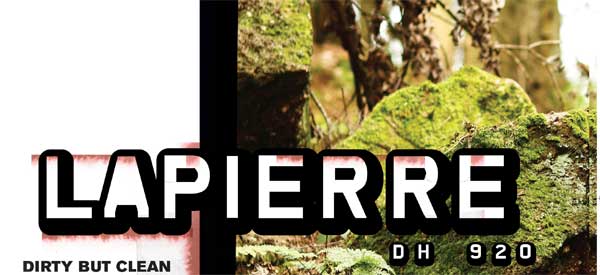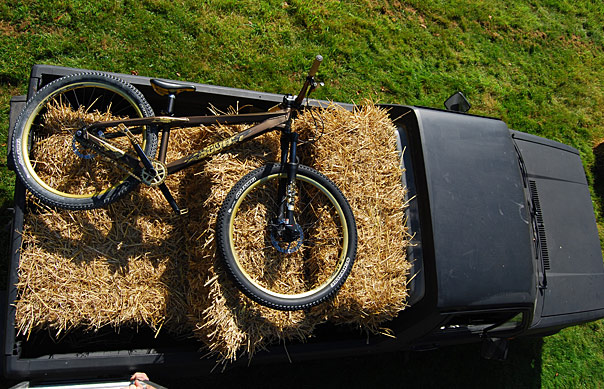
Words Steve Jones
Photos Victor Lucas
This is a typical piece of French artistry, the likes of which we have not seen since the heady days of Sunn. Who else could make a bicycle look just so bloody chic? The flowing top tube, colour coordinated pivot caps, derailleur hanger, chainring bolts, calliper covers, seat clamp, bar ends, brake adjusters – the mouldings in the shock area – the detail in things like fork bump– stops on the downtube all make this bike very, very… Stuck for some non–decorative parlance, I turned to the office…“sexy, special, bling, designed and engineered, slutty”. I guess the mirror like polish set off by the gold caps and the plentiful seat stays all flirt with the voyeuristic rubber–necking twitchers in the car park. But where Lapierre have really scored visually, and where it really matters, is by obscuring the leads. This is the one thing that makes this bike so very different from all the other production bikes. The Lapierre is devoid of brake and gear cable detritus. It’s dirty but clean. At no point on the frame lines do gear or brake cables interrupt the flow. It’s very clever and with the gold and silver has won over no end of people. It’s all very Armani this one.
A plethora of exemplary products have congregated around this finely made frame resulting in an altogether wholesome bike. Formula brakes aid the cable routing up front, whilst in the shit they remain one of the best brakes available. Saint is standard issue for 2009, the Thomson seatpost and stem coveted by riders everywhere. Keeping things rolling Lapierre have unsurprisingly gone for French hoops in Mavic and Hutchinson. Fox damping front and rear provide a reliable and balanced chassis. It’s tight, it’s light and it’s ready to roll.
RIDE
This bike rides pretty much like it looks. You’ll be living it up on the hill as much as in the car park. Because of the weight (just under 40lb) and geometry it’s a playful bike, quick to move at any sign of a good time. It’ll carve and it will lead perfectly in the way you want it too. On the flat it is
just so easy to pick up speed. It has life; it appears then to be an extremely fast bike. The suspension is deliciously supple. Its action on most terrain, certainly up to and past the first fifty percent, is very, very good. The linkage is silent and offers a good platform to push against, this bike rubberizes roots providing great grip and excellent predictability. There are just so many good points about the suspension on the rear, partly the result of having a very plush fork and shock that had been bedded in a touch, and partly the link system. It was looking difficult to fault in terms of
suspension. Most riders will simply love the ride the 920 offers. On the tight, not ridiculously steep British venues with flat root, places like Hopton, Bringewood, and large parts of Innerleithen, tracks with a certain amount of give in the root system, these are great places for the Lapierre. So there’s not a lot more to be said really because that’s exactly where a lot of people ride…it works. What I would put a question mark over is its behaviour when really put into the cauldron offered in some venues. Well known punch bags like Schladming, Champery and Pila. And less known places so bad that they are largely kept local. I’m not convinced on the Lapierre’s performance under continuous hits and braking in such places. Listen, this is being super critical, and pretty obvious, but basically what it comes down to is the fact that a Cane Creek, BOS or new Fox shock would take the bike a step further. Some people would prefer the company to be more precious about the damping than the decoration. The 920 is always great when in control, but when descending into the bigger piles of trouble those roots suddenly become a little less rubbery. The bike can be improved. With such an outstanding attention to detail we’d like to see a higher spec shock as is being increasingly being supplied by many other companies. On to more basic factors, such as the The cleanest and visually most well thought out downhill bike ever made. What cables? size and geometry being on the slightly steeper side of current frame geometry, and with a relatively short wheelbase on both sizes, I feel some riders will go for something that might offer that touch more stability. Interesting that diminutive team rider Danny Hart opted for the larger size towards the end of the season. I can only think if Danny is on the larger bike then six footers might run out of room
on the Lapierre. Certainly the 45.47” wheelbase of the large bike does seem a bit tight. For example the biggest 920 is still shorter than a small Commencal and a whole host of current medium sized downhill bikes. Size seems to be an issue. This is something that companies producing similar eight-inch bikes, such as Trek and Commencal, really have honed in on for 2009. We checked with the Lapierre factory on their sizing policy and they agree that taller riders are missing out here. The large (L) bike was made for Nicolas Vouilloz who is around the 5’ 9” mark. The small (S) initially made for other riders such as Danny Hart and other testers. The company bases their sizing on ‘average’ rider heights which they believe to be around 5’ 8”. Lapierre point out “People around the 5 ft 8 (average) size had the choice of a couple of frame lengths to allow them to get the perfect fit.” The large is basically a medium sized bike so don’t be put off. In fact its the size a lot of riders should go for.
FINALLY
Undoubtedly a real looker, Lapierre have pretty much pioneered a new approach to frame building with their unpolluted lines.
It really is a cut above in this department. The move to creating only one model of this bike also makes it even more special
because the componentry spec is probably up there as one of the best available. There are no choices; you can only get the best. It’s a different way of doing things that’s for sure. Out in the shit and muck the ride quality on average downhill terrain will be as good, if not better, than most bikes available, it really allows you to have a good time simply because it is a very straightforward bike. Then there’s the ‘twitch’ factor – the fact that a lot of blokes will think it looks great too will lead to some riders emptying their pockets that’s a cert. I feel however that for larger riders and racers who revel in more messy terrain they might be tempted to go for something that might offer a shade more stability with a different wheelbase. Shorter riders under six foot have got it well and truly sorted however and only the most demanding might look for some
revision on the production dampers. Is the 920 a tart’s bike then? Well you’d expect some bloke from the south of France with a load of medallions to own one that’s for sure. You know, the kind of guy who’d come out once a year and destroy everyone. Now there’s a thought, but I’m afraid it doesn’t look like a downhill appearance from the great Lapierre ambassador Nicolas Vouilloz is on the cards any time soon. But the answer to the question? No it’s not a tarts bike, and it’s not expensive when you consider the build kit and uniquely excellent engineering. It’s class.






